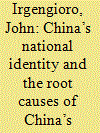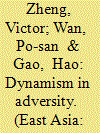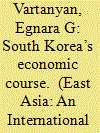|
|
|
Sort Order |
|
|
|
Items / Page
|
|
|
|
|
|
|
| Srl | Item |
| 1 |
ID:
163319


|
|
|
|
|
| Summary/Abstract |
This paper seeks to examine the People’s Republic of China’s (China) self-defined national identity and the consequences on China’s ethnic relations with its ethnic minorities. This paper argues that China’s identity is equated with the identity and culture of its ethnic Han Chinese majority—a narrative originally constructed by the Chinese state which its ethnic Han Chinese majority since indulges in. However, this hegemonic narrative is at the root of interethnic issues and tensions in China today, as further ethnic tensions stem from the resistance of ethnic minorities against Sinicization and the imposition of this “Chinese” identity against them. These phenomena thus both indicate what I term a weak “internal soft power appeal” of Han Chinese Confucian culture for ethnic minorities living in the PRC, and imply that China must adopt a different, more inclusive national identity if it were to maintain ethnic stability in the long term.
|
|
|
|
|
|
|
|
|
|
|
|
|
|
|
|
| 2 |
ID:
163323


|
|
|
| 3 |
ID:
163321


|
|
|
|
|
| Summary/Abstract |
This paper addresses the long debate over the superiority of the performance of family- vs non-family-controlled companies from the contesting perspectives of entrepreneurial familism and managerial capitalism. Publicly listed family- and non-family-controlled companies in Hong Kong have been selected for a comparison of their overall performance. The focus is on Hang Seng Index constituent companies in general, and on two cases in particular: one non-family-controlled bank (HSBC), and one family-controlled bank (BEA). We found that family-controlled companies were not necessarily less competitive than non-family-controlled companies. Specifically, when HSBC and BEA were compared, the latter showed no clear inferiority in operating profit margin and return on assets, even though the former enjoys unparalleled advantages, such as an overwhelming superiority in size, the privilege of issuing notes, and status as Hong Kong’s quasi-central bank. Therefore, we argue that entrepreneurial familism seems to be a resilient source of business dynamism, particularly when family-controlled companies have been repeatedly tested by adverse socioeconomic crises. Based on the finding, it is suggested that governments across the world should provide a favorable institutional set-up to facilitate the development of family businesses.
|
|
|
|
|
|
|
|
|
|
|
|
|
|
|
|
| 4 |
ID:
163322


|
|
|
|
|
| Summary/Abstract |
Carrie Lam Cheng Yuet-ngor has broken many ceilings as Hong Kong’s first female Chief Executive and the first post-Occupy Central leader. The mission of the political biographer is to contextualize Lam’s policies in the circumstances that she was put into and/or inherited from previous administrations without any value judgments (or highly minimized ones). The purpose is to recognize Lam as a complex entity characterized by a triad of images that include caring a senior civil servant, a tough-talking iron lady (nicknamed “The Fighter”) and a compliant Beijing loyalist (nicknamed “The Puppet” or “CY Leung 2.0”). The readers are the ultimate arbiters and evaluators of these narratives and perceptions to craft their own impression of Lam. The writing is organized into sections analyzing Lam’s family background, her rise in the civil service, her appointment as Chief Secretary, and her current tenure as the Chief Executive. The significance of this writing is an early assessment of Lam’s achievements and policy direction and a recount of her initiatives when she was Chief Secretary that can later be compared to post-administration retirement biographical writings for a full understanding of her political achievements and failures. Taken together, these accounts can then be a combined diachronic and synchronic historical biographical accounts of Lam.
|
|
|
|
|
|
|
|
|
|
|
|
|
|
|
|
| 5 |
ID:
163318


|
|
|
|
|
| Summary/Abstract |
Since the 1980s, Japan’s war memory has strained its relations with South Korea and China, to a less degree, the USA. Two of the thorniest issues are the comfort women and the US atomic bombing of Japan. Before the Obama administration announced its policy pivot to Asia in 2011, both Japanese and American leaders were reluctant to make amends for the past acts of their countries. However, in 2015, the Japanese conservative Prime Minister Abe reached an agreement with South Korea that “finally and irreversibly” resolved the comfort women issue, thus achieving a historic reconciliation between the two countries. In 2016, then President Obama visited Hiroshima to commemorate the atomic bomb victims. Then, in December 2016, the comfort women issue resurfaced in Japan and South Korea relations, indicating a failure of the reconciliation. Why did the USA change its policy on historical issues involving Japan? Why did Abe and the South Korean President Park Geun-hye settle the comfort women issue? Why did Obama visit Hiroshima? Why did the reconciliation fail? In this article, I propose a rational choice theory to answer these questions. Applying the proposed theory and relying on available evidence, I argue that the settlement of the comfort women issue and Obama’s visit to Hiroshima are important components of Obama’s pivot to Asia to balance China’s rise. The reconciliation failed mainly because it did not resolve the historical justice issue promoted by the human rights norms. I discuss some implications for reconciliation in Northeast Asia.
|
|
|
|
|
|
|
|
|
|
|
|
|
|
|
|
| 6 |
ID:
163320


|
|
|
|
|
| Summary/Abstract |
The paper aims to investigate the transformation of South Korean economy from strict state regulation to liberalization and to fill in the gap in the historical analysis of the transition from import-substitution to export-oriented economy of South Korea. The study relies on the methods of comparative-historical, historical-typological, and historical-genetic analysis to consider the evolution of South Korean economic system, the change in economic development model, and the transition to a new economic strategy. The study also implies the use of interdisciplinary methods to systematize the empirical material, applying political-geographic, economic, and complex approaches. The paper gives periodization of South Korean economic development and investigates the reasons of country’s successful modernization and transition to export-oriented economy. Large corporations began to emerge in South Korea in the mid-1960s due to the active support from the state. They established the production of steel, marine vessels, automobiles, and electronic devices. The well thought-out government program brought notable success by the late 1990s, and South Korea gained the developed industrial base and powerful export potential. The afflux of foreign investments and the competitiveness of Korean products were mostly provided by low wages, traditional diligence, and Confucian education. Since the Korean strategy of economic development happened to be successful, there is a need for examining the experience of modernization as it can be useful for developing countries.
|
|
|
|
|
|
|
|
|
|
|
|
|
|
|
|
|
|
|
|
|